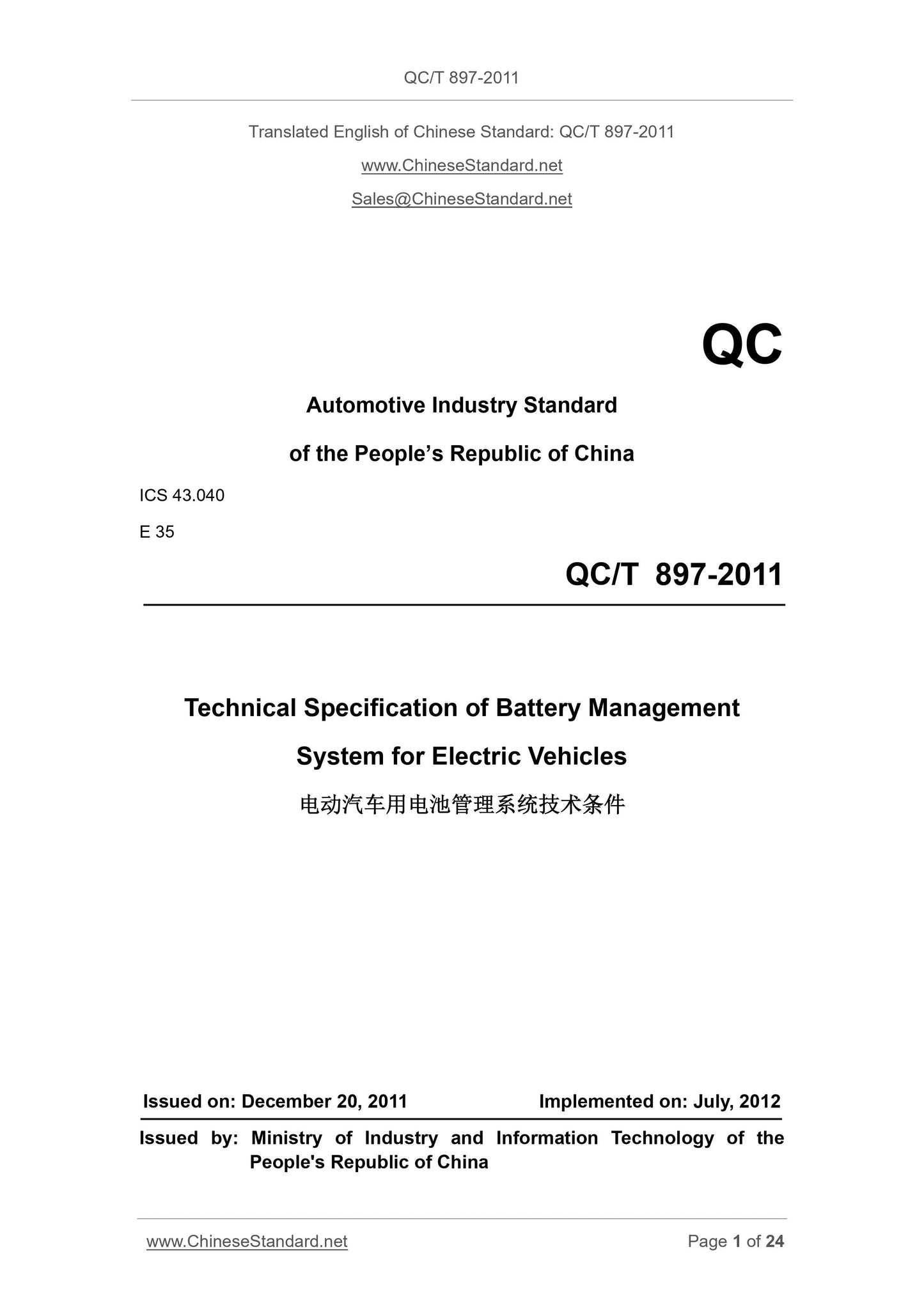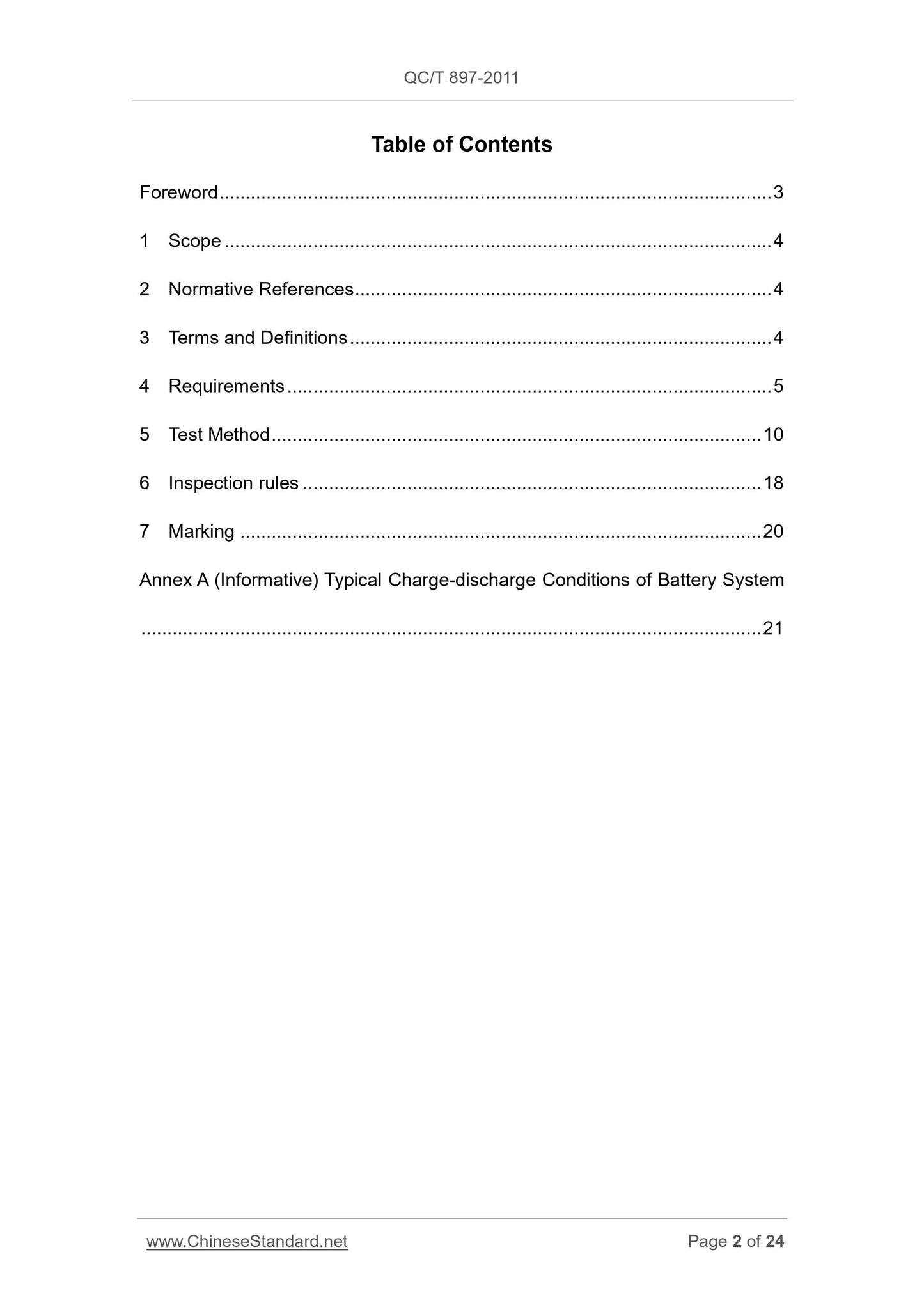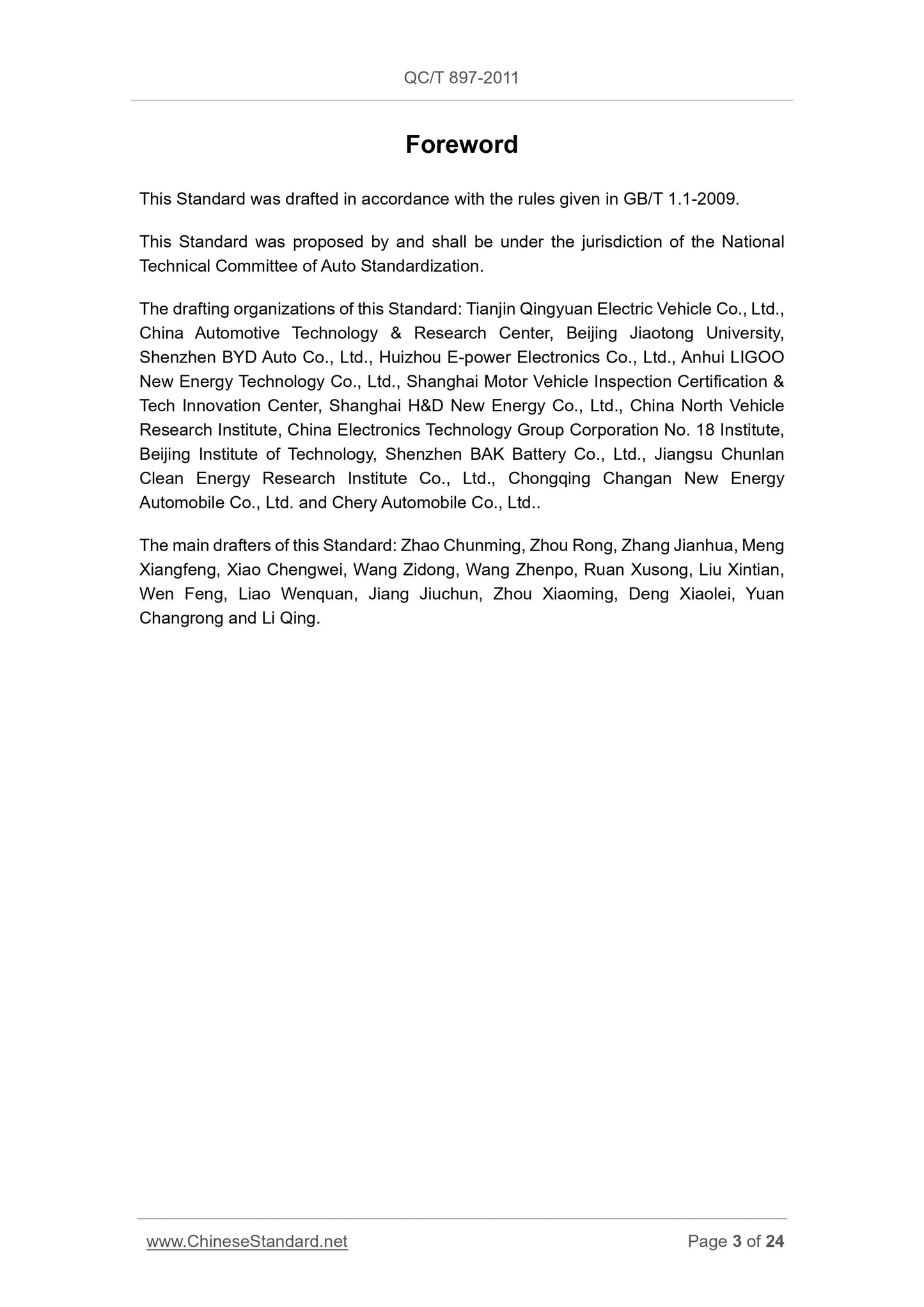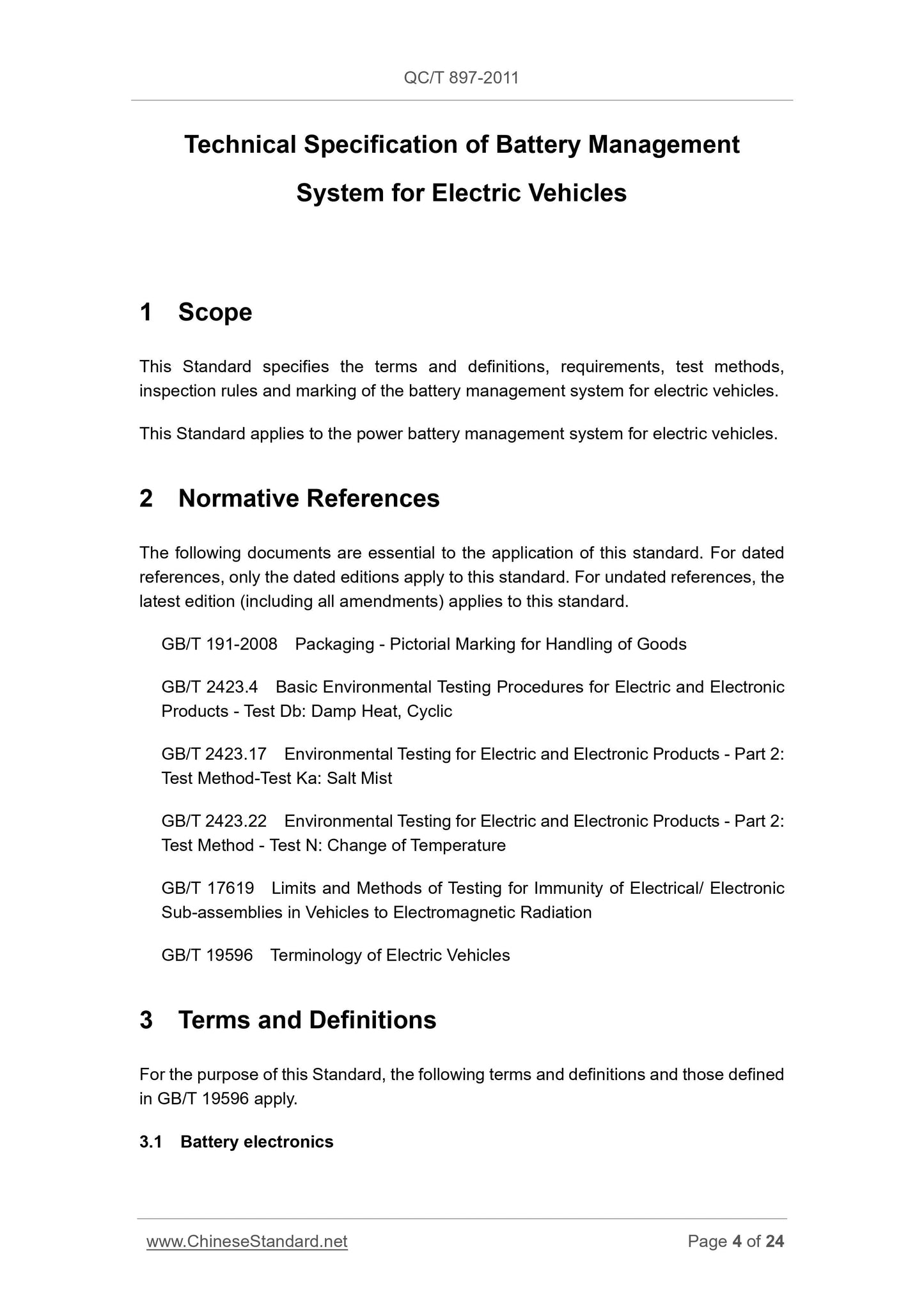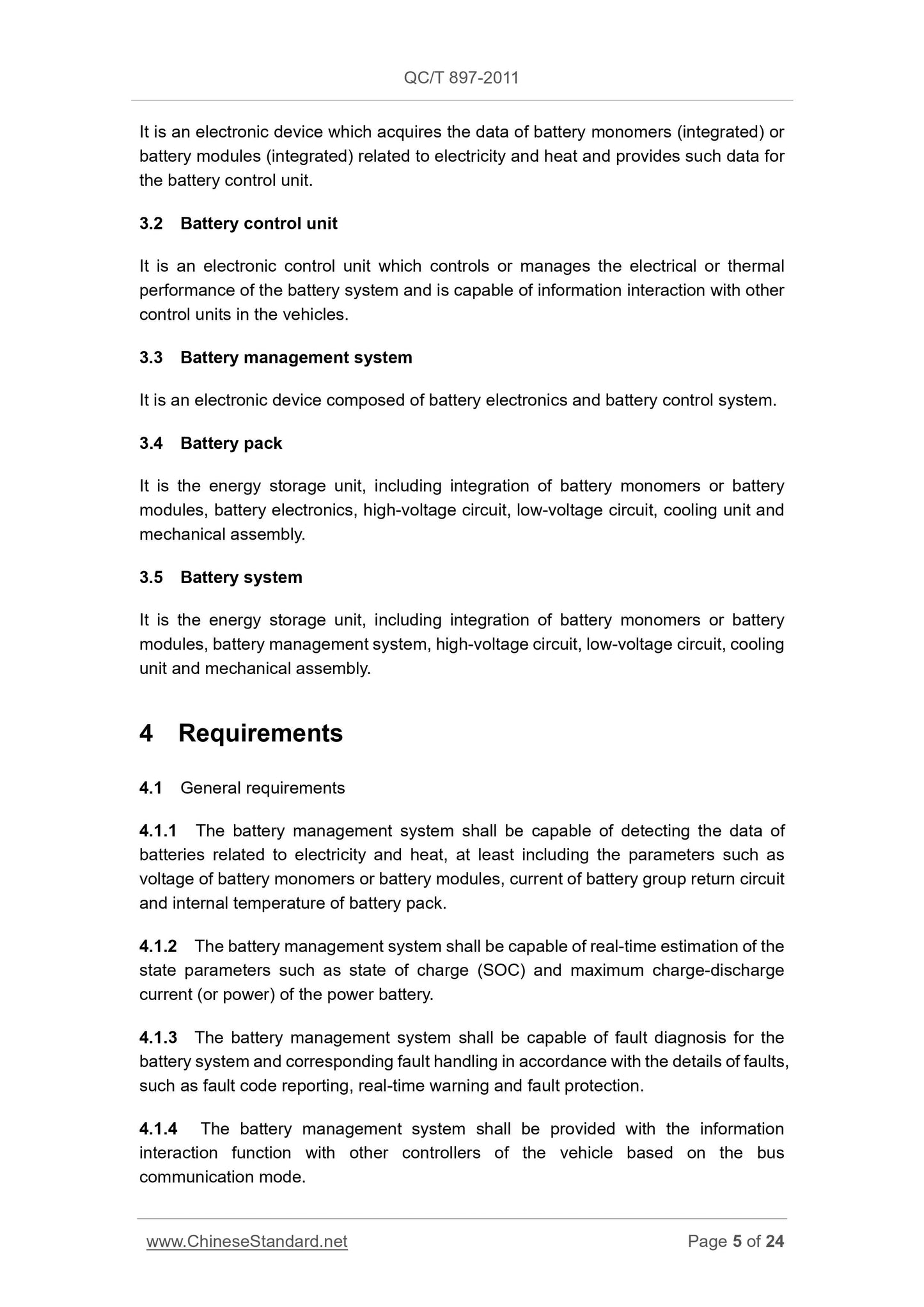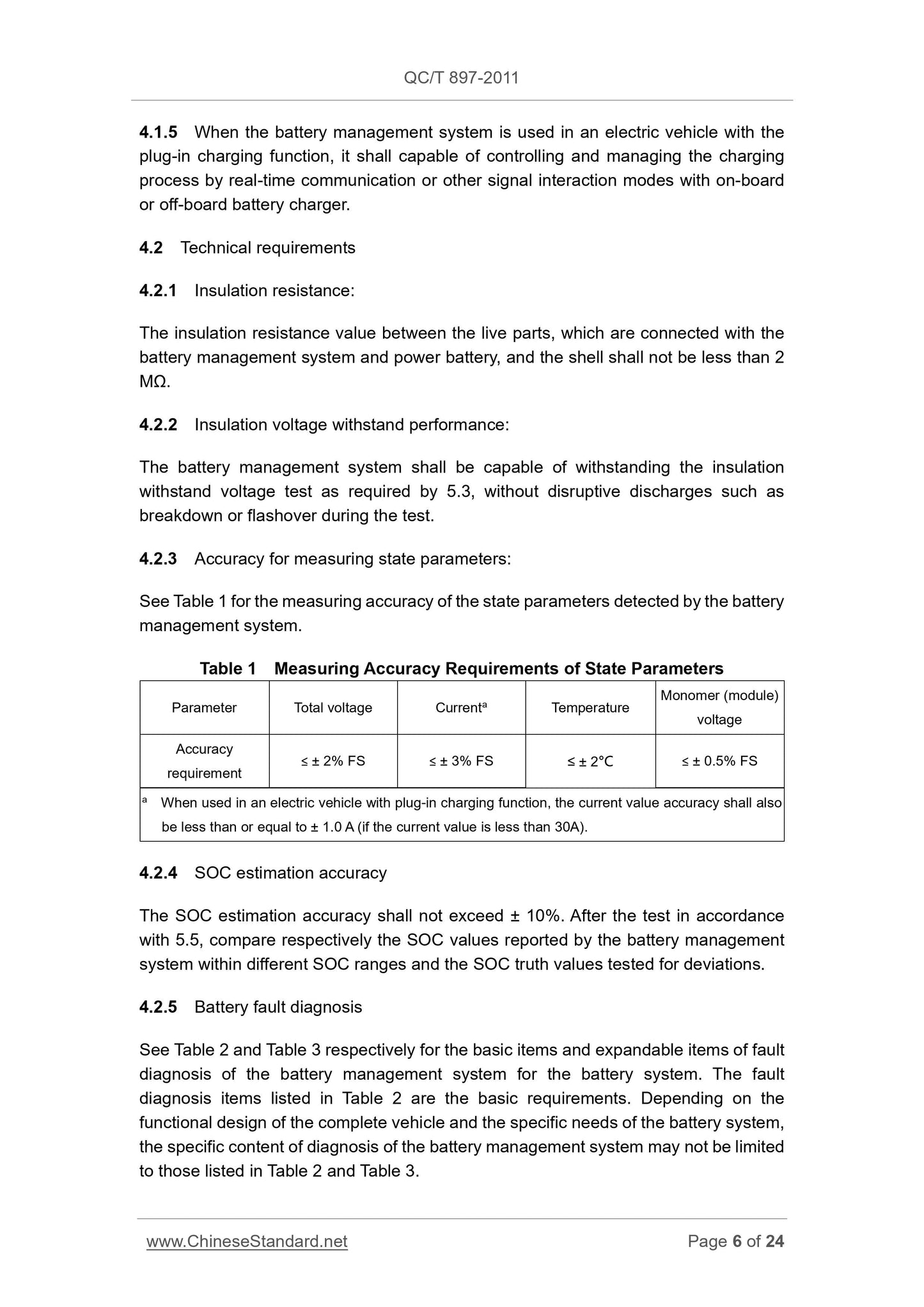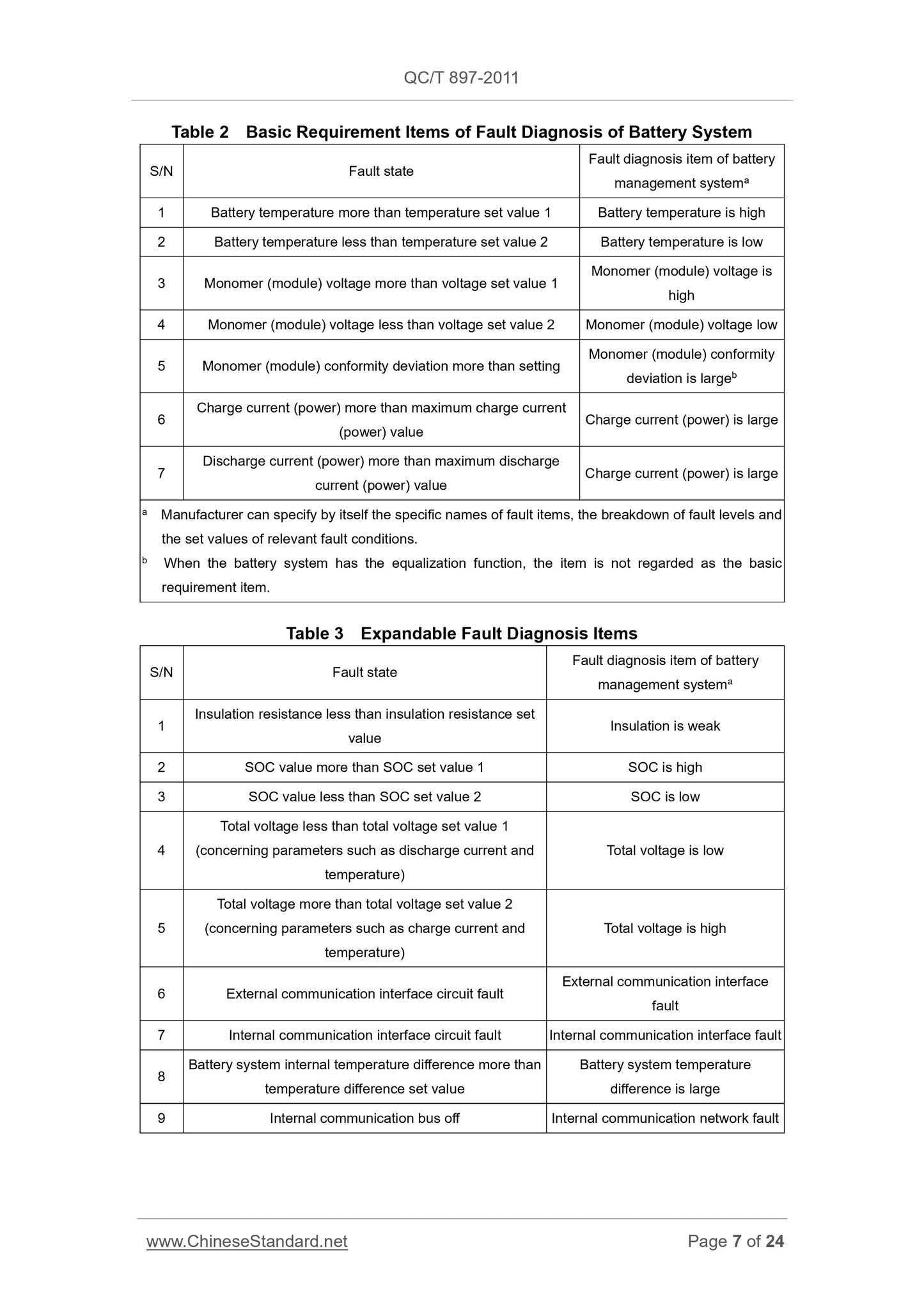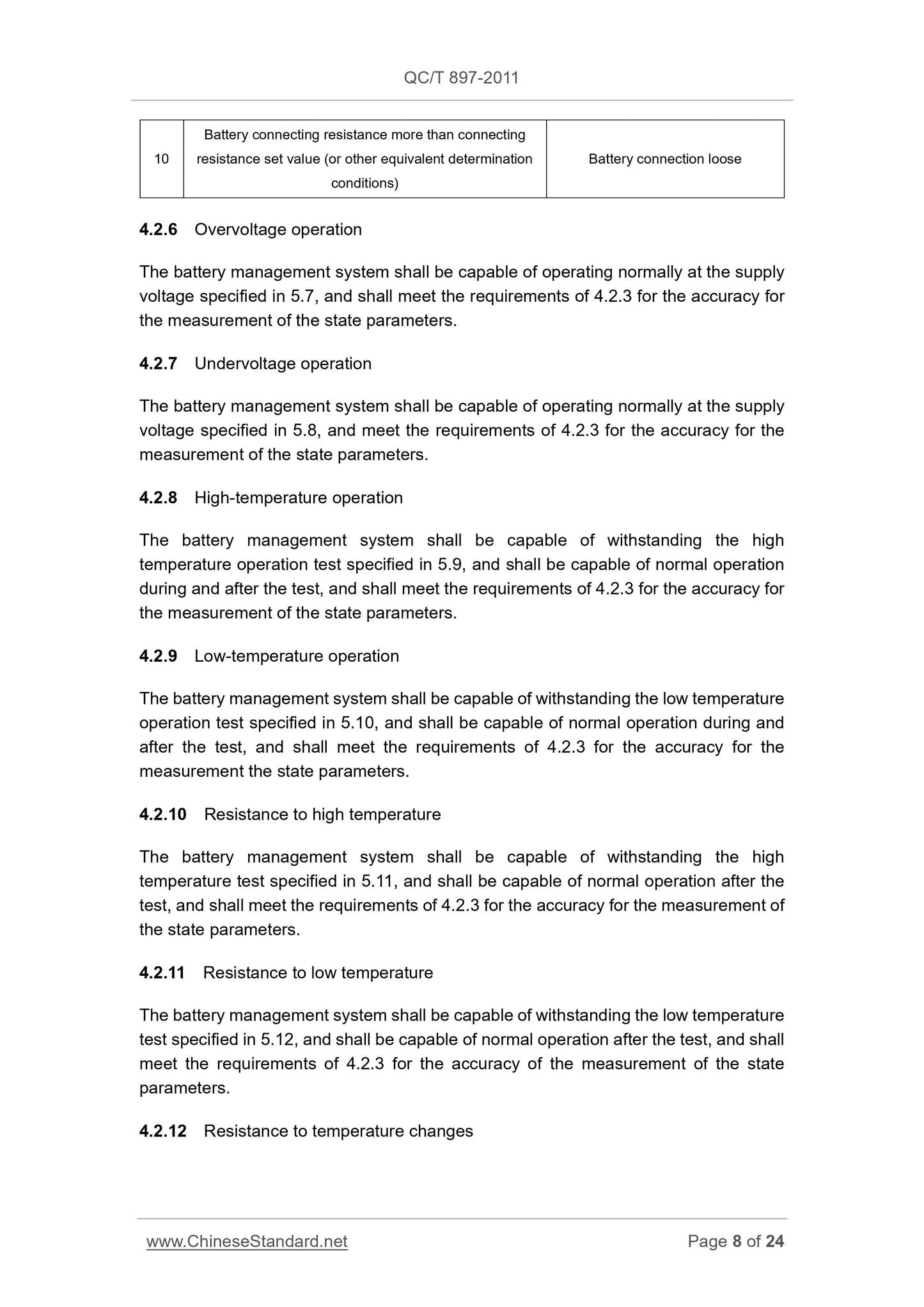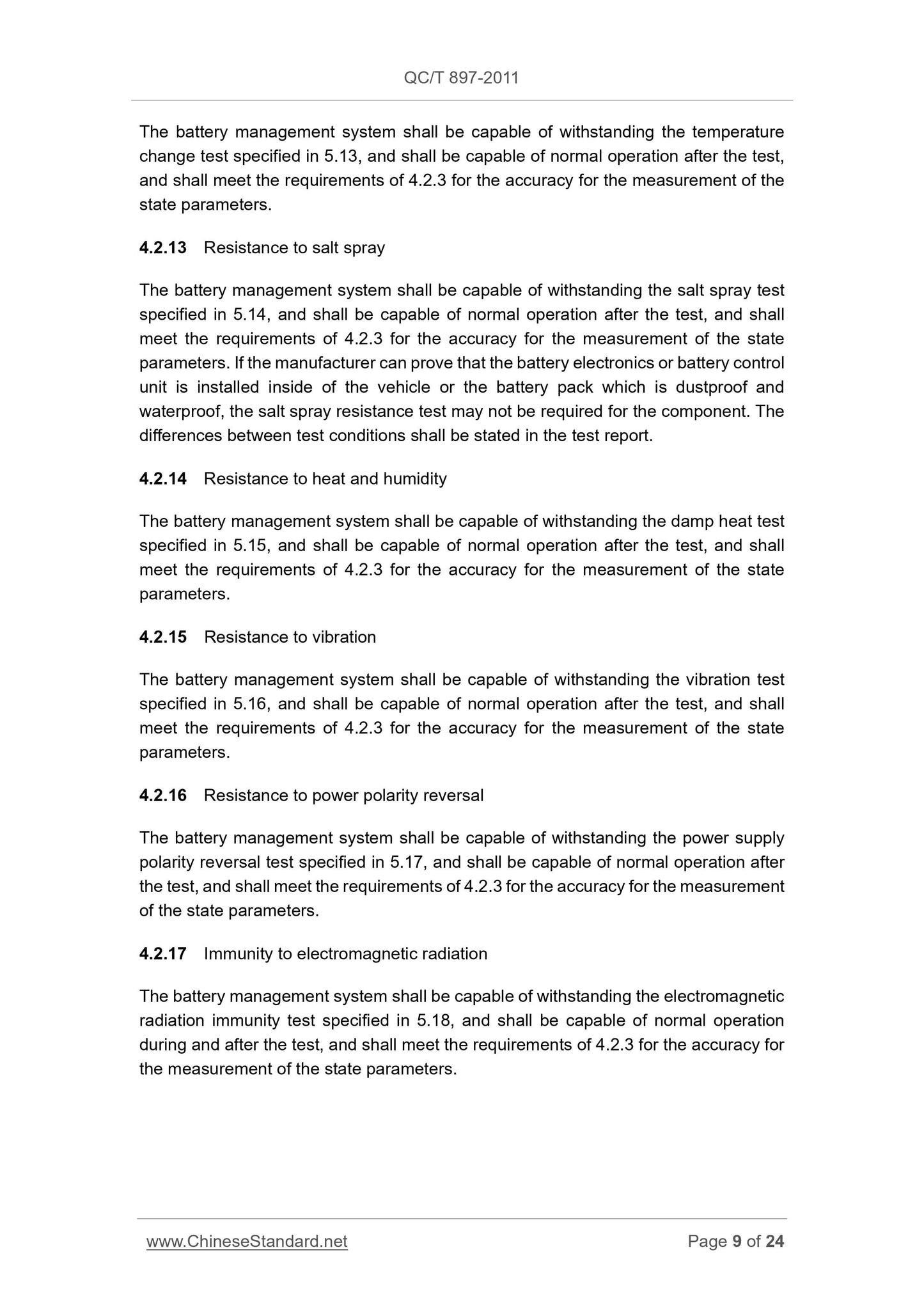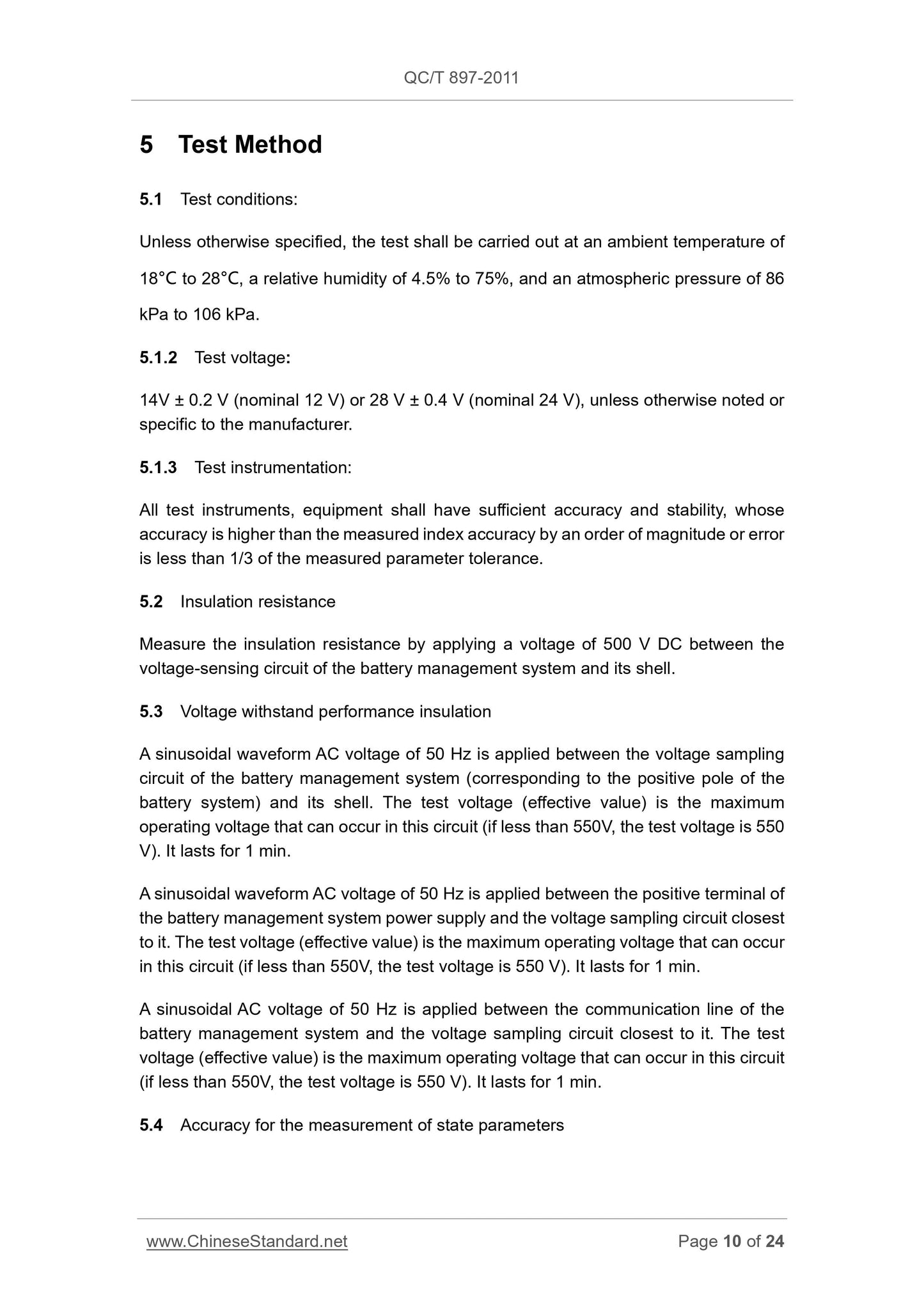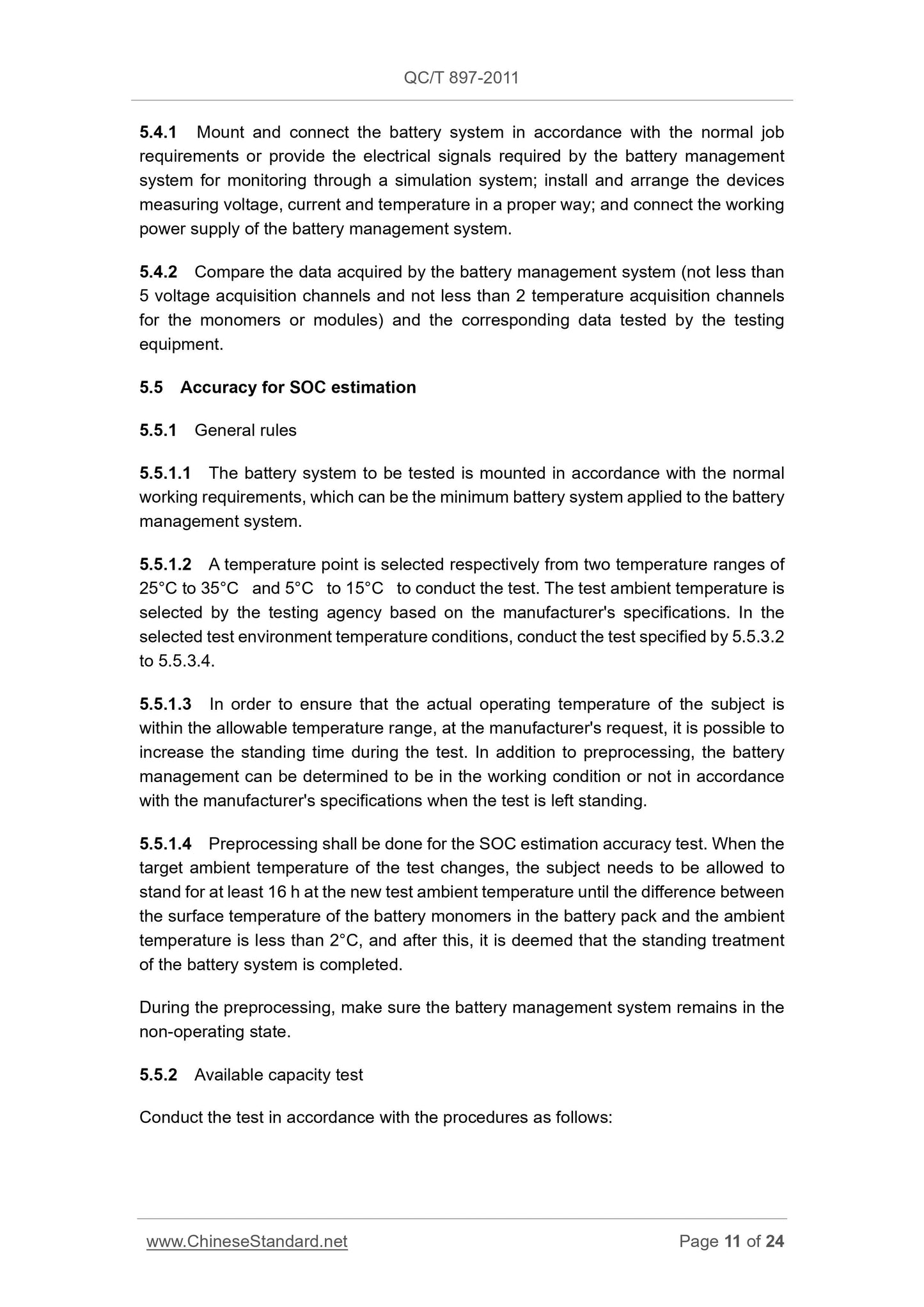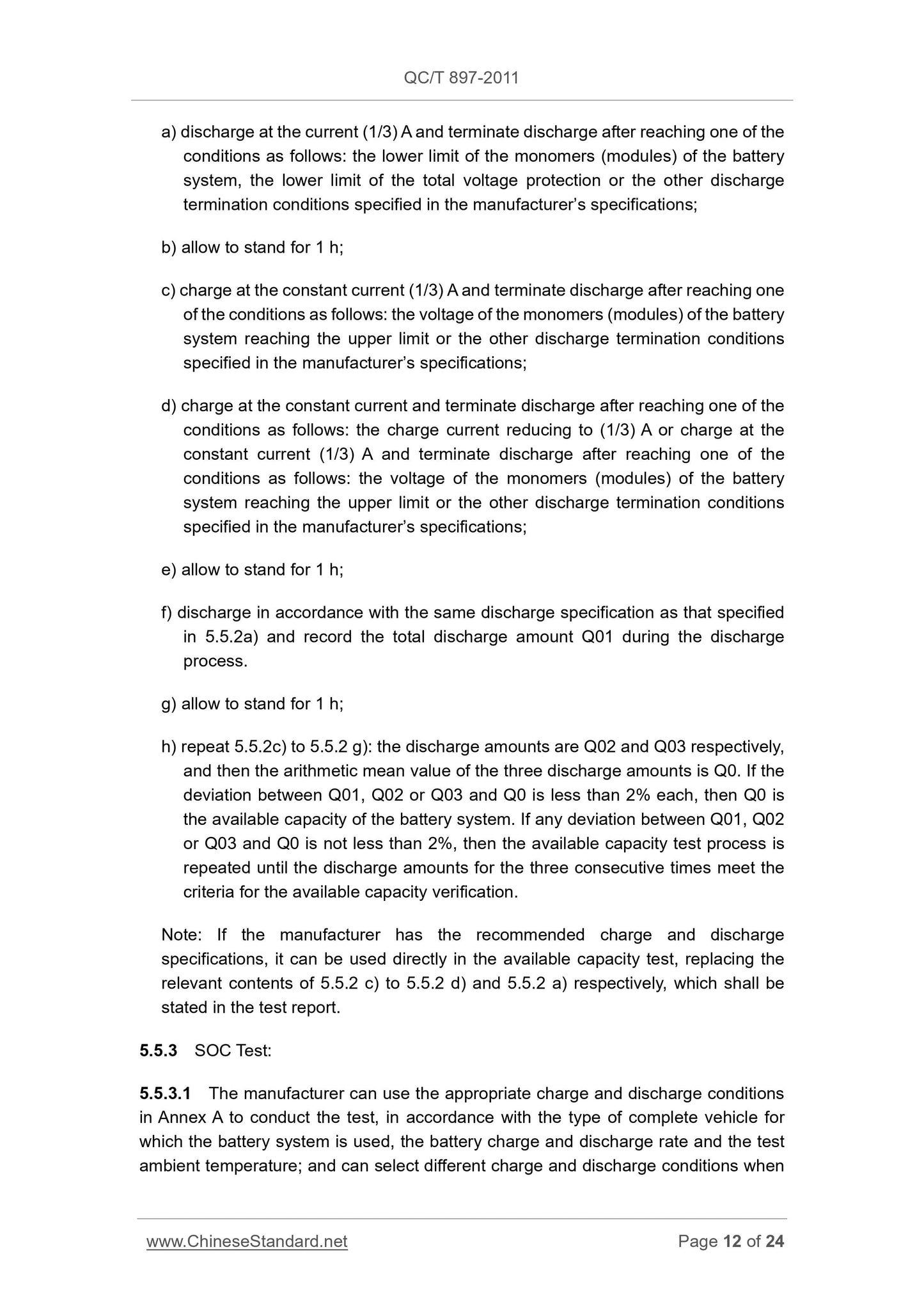1
/
de
12
PayPal, credit cards. Download editable-PDF & invoice in 1 second!
QC/T 897-2011 English PDF (QCT897-2011)
QC/T 897-2011 English PDF (QCT897-2011)
Prix habituel
$125.00 USD
Prix habituel
Prix promotionnel
$125.00 USD
Prix unitaire
/
par
Frais d'expédition calculés à l'étape de paiement.
Impossible de charger la disponibilité du service de retrait
Delivery: 3 seconds. Download true-PDF + Invoice.
Get QUOTATION in 1-minute: Click QC/T 897-2011
Historical versions: QC/T 897-2011
Preview True-PDF (Reload/Scroll if blank)
QC/T 897-2011: Technical specification of battery management system for electric vehicles
QC/T 897-2011
QC
Automotive Industry Standard
of the People’s Republic of China
ICS 43.040
E 35
Technical Specification of Battery Management
System for Electric Vehicles
ISSUED ON. DECEMBER 20, 2011
IMPLEMENTED ON. JULY, 2012
Issued by. Ministry of Industry and Information Technology of the
People's Republic of China
Table of Contents
Foreword ... 3
1 Scope ... 4
2 Normative References ... 4
3 Terms and Definitions ... 4
4 Requirements ... 5
5 Test Method ... 10
6 Inspection rules ... 18
7 Marking ... 20
Annex A (Informative) Typical Charge-discharge Conditions of Battery System
... 21
Foreword
This Standard was drafted in accordance with the rules given in GB/T 1.1-2009.
This Standard was proposed by and shall be under the jurisdiction of the National
Technical Committee of Auto Standardization.
The drafting organizations of this Standard. Tianjin Qingyuan Electric Vehicle Co., Ltd.,
China Automotive Technology and Research Center, Beijing Jiaotong University,
Shenzhen BYD Auto Co., Ltd., Huizhou E-power Electronics Co., Ltd., Anhui LIGOO
New Energy Technology Co., Ltd., Shanghai Motor Vehicle Inspection Certification and
Tech Innovation Center, Shanghai H and D New Energy Co., Ltd., China North Vehicle
Research Institute, China Electronics Technology Group Corporation No. 18 Institute,
Beijing Institute of Technology, Shenzhen BAK Battery Co., Ltd., Jiangsu Chunlan
Clean Energy Research Institute Co., Ltd., Chongqing Changan New Energy
Automobile Co., Ltd. and Chery Automobile Co., Ltd..
The main drafters of this Standard. Zhao Chunming, Zhou Rong, Zhang Jianhua, Meng
Xiangfeng, Xiao Chengwei, Wang Zidong, Wang Zhenpo, Ruan Xusong, Liu Xintian,
Wen Feng, Liao Wenquan, Jiang Jiuchun, Zhou Xiaoming, Deng Xiaolei, Yuan
Changrong and Li Qing.
Technical Specification of Battery Management
System for Electric Vehicles
1 Scope
This Standard specifies the terms and definitions, requirements, test methods,
inspection rules and marking of the battery management system for electric vehicles.
This Standard applies to the power battery management system for electric vehicles.
2 Normative References
The following documents are essential to the application of this standard. For dated
references, only the dated editions apply to this standard. For undated references, the
latest edition (including all amendments) applies to this standard.
GB/T 191-2008 Packaging - Pictorial Marking for Handling of Goods
GB/T 2423.4 Basic Environmental Testing Procedures for Electric and Electronic
Products - Test Db. Damp Heat, Cyclic
GB/T 2423.17 Environmental Testing for Electric and Electronic Products - Part 2.
Test Method-Test Ka. Salt Mist
GB/T 2423.22 Environmental Testing for Electric and Electronic Products - Part 2.
Test Method - Test N. Change of Temperature
GB/T 17619 Limits and Methods of Testing for Immunity of Electrical/ Electronic
Sub-assemblies in Vehicles to Electromagnetic Radiation
GB/T 19596 Terminology of Electric Vehicles
3 Terms and Definitions
For the purpose of this Standard, the following terms and definitions and those defined
in GB/T 19596 apply.
3.1 Battery electronics
Battery connecting resistance more than connecting
resistance set value (or other equivalent determination
conditions)
Battery connection loose
4.2.6 Overvoltage operation
The battery management system shall be capable of operating normally at the supply
voltage specified in 5.7, and shall meet the requirements of 4.2.3 for the accuracy for
the measurement of the state parameters.
4.2.7 Undervoltage operation
The battery management system shall be capable of operating normally at the supply
voltage specified in 5.8, and meet the requirements of 4.2.3 for the accuracy for the
measurement of the state parameters.
4.2.8 High-temperature operation
The battery management system shall be capable of withstanding the high
temperature operation test specified in 5.9, and shall be capable of normal operation
during and after the test, and shall meet the requirements of 4.2.3 for the accuracy for
the measurement of the state parameters.
4.2.9 Low-temperature operation
The battery management system shall be capable of withstanding the low temperature
operation test specified in 5.10, and shall be capable of normal operation during and
after the test, and shall meet the requirements of 4.2.3 for the accuracy for the
measurement the state parameters.
4.2.10 Resistance to high temperature
The battery management system shall be capable of withstanding the high
temperature test specified in 5.11, and shall be capable of normal operation after the
test, and shall meet the requirements of 4.2.3 for the accuracy for the measurement of
the state parameters.
4.2.11 Resistance to low temperature
The battery management system shall be capable of withstanding the low temperature
test specified in 5.12, and shall be capable of normal operation after the test, and shall
meet the requirements of 4.2.3 for the accuracy of the measurement of the state
parameters.
4.2.12 Resistance to temperature changes
a) discharge at the current (1/3) A and terminate discharge after reaching one of the
conditions as follows. the lower limit of the monomers (modules) of the battery
system, the lower limit of the total voltage protection or the other discharge
termination conditions specified in the manufacturer’s specifications;
b) allow to stand for 1 h;
c) charge at the constant current (1/3) A and terminate discharge after reaching one
of the conditions as follows. the voltage of the monomers (modules) of the battery
system reaching the upper limit or the other discharge termination conditions
specified in the manufacturer’s specifications;
d) charge at the constant current and terminate discharge after reaching one of the
conditions as follows. the charge current reducing to (1/3) A or charge at the
constant current (1/3) A and terminate discharge after reaching one of the
conditions as follows. the voltage of the monomers (modules) of the battery
system reaching the upper limit or the other discharge termination conditions
specified in the manufacturer’s specifications;
e) allow to stand for 1 h;
f) discharge in accordance with the same discharge specification as that specified
in 5.5.2a) and record the total discharge amount Q01 during the discharge
process.
g) allow to stand for 1 h;
h) repeat 5.5.2c) to 5.5.2 g). the discharge amounts are Q02 and Q03 respectively,
and then the arithmetic mean value of the three discharge amounts is Q0. If the
deviation between Q01, Q02 or Q03 and Q0 is less than 2% each, then Q0 is
the available capacity of the battery system. If any deviation between Q01, Q02
or Q03 and Q0 is not less than 2%, then the available capacity test process is
repeated until the discharge amounts for the three consecutive times meet the
criteria for the available capacity verification.
Note. If the manufacturer has the recommended charge and discharge
specifications, it can be used directly in the available capacity test, replacing the
relevant contents of 5.5.2 c) to 5.5.2 d) and 5.5.2 a) respectively, which shall be
stated in the test report.
5.5.3 SOC Test.
5.5.3.1 The manufacturer can use the appropriate charge and discharge conditions
in Annex A to conduct the test, in accordance with the type of complete vehicle for
which the battery system is used, the battery...
Get QUOTATION in 1-minute: Click QC/T 897-2011
Historical versions: QC/T 897-2011
Preview True-PDF (Reload/Scroll if blank)
QC/T 897-2011: Technical specification of battery management system for electric vehicles
QC/T 897-2011
QC
Automotive Industry Standard
of the People’s Republic of China
ICS 43.040
E 35
Technical Specification of Battery Management
System for Electric Vehicles
ISSUED ON. DECEMBER 20, 2011
IMPLEMENTED ON. JULY, 2012
Issued by. Ministry of Industry and Information Technology of the
People's Republic of China
Table of Contents
Foreword ... 3
1 Scope ... 4
2 Normative References ... 4
3 Terms and Definitions ... 4
4 Requirements ... 5
5 Test Method ... 10
6 Inspection rules ... 18
7 Marking ... 20
Annex A (Informative) Typical Charge-discharge Conditions of Battery System
... 21
Foreword
This Standard was drafted in accordance with the rules given in GB/T 1.1-2009.
This Standard was proposed by and shall be under the jurisdiction of the National
Technical Committee of Auto Standardization.
The drafting organizations of this Standard. Tianjin Qingyuan Electric Vehicle Co., Ltd.,
China Automotive Technology and Research Center, Beijing Jiaotong University,
Shenzhen BYD Auto Co., Ltd., Huizhou E-power Electronics Co., Ltd., Anhui LIGOO
New Energy Technology Co., Ltd., Shanghai Motor Vehicle Inspection Certification and
Tech Innovation Center, Shanghai H and D New Energy Co., Ltd., China North Vehicle
Research Institute, China Electronics Technology Group Corporation No. 18 Institute,
Beijing Institute of Technology, Shenzhen BAK Battery Co., Ltd., Jiangsu Chunlan
Clean Energy Research Institute Co., Ltd., Chongqing Changan New Energy
Automobile Co., Ltd. and Chery Automobile Co., Ltd..
The main drafters of this Standard. Zhao Chunming, Zhou Rong, Zhang Jianhua, Meng
Xiangfeng, Xiao Chengwei, Wang Zidong, Wang Zhenpo, Ruan Xusong, Liu Xintian,
Wen Feng, Liao Wenquan, Jiang Jiuchun, Zhou Xiaoming, Deng Xiaolei, Yuan
Changrong and Li Qing.
Technical Specification of Battery Management
System for Electric Vehicles
1 Scope
This Standard specifies the terms and definitions, requirements, test methods,
inspection rules and marking of the battery management system for electric vehicles.
This Standard applies to the power battery management system for electric vehicles.
2 Normative References
The following documents are essential to the application of this standard. For dated
references, only the dated editions apply to this standard. For undated references, the
latest edition (including all amendments) applies to this standard.
GB/T 191-2008 Packaging - Pictorial Marking for Handling of Goods
GB/T 2423.4 Basic Environmental Testing Procedures for Electric and Electronic
Products - Test Db. Damp Heat, Cyclic
GB/T 2423.17 Environmental Testing for Electric and Electronic Products - Part 2.
Test Method-Test Ka. Salt Mist
GB/T 2423.22 Environmental Testing for Electric and Electronic Products - Part 2.
Test Method - Test N. Change of Temperature
GB/T 17619 Limits and Methods of Testing for Immunity of Electrical/ Electronic
Sub-assemblies in Vehicles to Electromagnetic Radiation
GB/T 19596 Terminology of Electric Vehicles
3 Terms and Definitions
For the purpose of this Standard, the following terms and definitions and those defined
in GB/T 19596 apply.
3.1 Battery electronics
Battery connecting resistance more than connecting
resistance set value (or other equivalent determination
conditions)
Battery connection loose
4.2.6 Overvoltage operation
The battery management system shall be capable of operating normally at the supply
voltage specified in 5.7, and shall meet the requirements of 4.2.3 for the accuracy for
the measurement of the state parameters.
4.2.7 Undervoltage operation
The battery management system shall be capable of operating normally at the supply
voltage specified in 5.8, and meet the requirements of 4.2.3 for the accuracy for the
measurement of the state parameters.
4.2.8 High-temperature operation
The battery management system shall be capable of withstanding the high
temperature operation test specified in 5.9, and shall be capable of normal operation
during and after the test, and shall meet the requirements of 4.2.3 for the accuracy for
the measurement of the state parameters.
4.2.9 Low-temperature operation
The battery management system shall be capable of withstanding the low temperature
operation test specified in 5.10, and shall be capable of normal operation during and
after the test, and shall meet the requirements of 4.2.3 for the accuracy for the
measurement the state parameters.
4.2.10 Resistance to high temperature
The battery management system shall be capable of withstanding the high
temperature test specified in 5.11, and shall be capable of normal operation after the
test, and shall meet the requirements of 4.2.3 for the accuracy for the measurement of
the state parameters.
4.2.11 Resistance to low temperature
The battery management system shall be capable of withstanding the low temperature
test specified in 5.12, and shall be capable of normal operation after the test, and shall
meet the requirements of 4.2.3 for the accuracy of the measurement of the state
parameters.
4.2.12 Resistance to temperature changes
a) discharge at the current (1/3) A and terminate discharge after reaching one of the
conditions as follows. the lower limit of the monomers (modules) of the battery
system, the lower limit of the total voltage protection or the other discharge
termination conditions specified in the manufacturer’s specifications;
b) allow to stand for 1 h;
c) charge at the constant current (1/3) A and terminate discharge after reaching one
of the conditions as follows. the voltage of the monomers (modules) of the battery
system reaching the upper limit or the other discharge termination conditions
specified in the manufacturer’s specifications;
d) charge at the constant current and terminate discharge after reaching one of the
conditions as follows. the charge current reducing to (1/3) A or charge at the
constant current (1/3) A and terminate discharge after reaching one of the
conditions as follows. the voltage of the monomers (modules) of the battery
system reaching the upper limit or the other discharge termination conditions
specified in the manufacturer’s specifications;
e) allow to stand for 1 h;
f) discharge in accordance with the same discharge specification as that specified
in 5.5.2a) and record the total discharge amount Q01 during the discharge
process.
g) allow to stand for 1 h;
h) repeat 5.5.2c) to 5.5.2 g). the discharge amounts are Q02 and Q03 respectively,
and then the arithmetic mean value of the three discharge amounts is Q0. If the
deviation between Q01, Q02 or Q03 and Q0 is less than 2% each, then Q0 is
the available capacity of the battery system. If any deviation between Q01, Q02
or Q03 and Q0 is not less than 2%, then the available capacity test process is
repeated until the discharge amounts for the three consecutive times meet the
criteria for the available capacity verification.
Note. If the manufacturer has the recommended charge and discharge
specifications, it can be used directly in the available capacity test, replacing the
relevant contents of 5.5.2 c) to 5.5.2 d) and 5.5.2 a) respectively, which shall be
stated in the test report.
5.5.3 SOC Test.
5.5.3.1 The manufacturer can use the appropriate charge and discharge conditions
in Annex A to conduct the test, in accordance with the type of complete vehicle for
which the battery system is used, the battery...
Share
